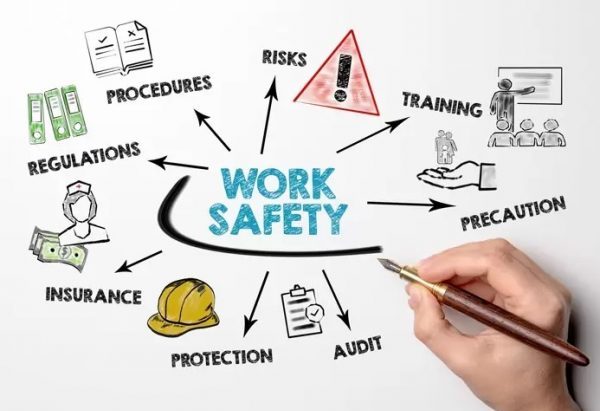Understanding Workplace Safety Ratings: A Comprehensive Guide
Workplace safety ratings are crucial indicators of a company’s commitment to maintaining a safe and healthy environment for its employees. These ratings help assess and benchmark how well a business manages potential risks and ensures the well-being of its workforce. Whether you’re an employer or an employee, understanding these ratings can help you make informed decisions about safety practices in the workplace.

What Are Workplace Safety Ratings?
Workplace safety ratings are assessments of how effectively a company manages workplace hazards. They consider various factors, including employee safety protocols, risk management strategies, and compliance with health and safety regulations. These ratings provide an overall picture of how safe a workplace is for its employees and can influence everything from insurance premiums to employee satisfaction.
A high workplace safety rating indicates that a company has successfully implemented measures to reduce accidents, promote health, and manage risks. On the other hand, a low rating may suggest that improvements are needed in one or more areas of safety.
How Are Workplace Safety Ratings Calculated?
Workplace safety ratings are calculated based on a variety of factors that reflect a company’s commitment to health and safety. Some of the main aspects considered include:
-
Accident History: A company with a low number of workplace accidents or injuries tends to receive higher safety ratings.
-
Risk Management: The effectiveness of a company’s risk management strategies, including hazard assessments and safety training programs.
-
Compliance with Safety Regulations: Adherence to local, national, and international health and safety standards plays a significant role in determining safety ratings.
-
Employee Feedback: Employee surveys, interviews, and safety audits help provide a comprehensive picture of the company’s safety culture.
Each factor is weighted according to its relevance to the company’s overall safety performance. The final score determines the company’s rating, which is usually presented as a numerical score or a letter grade.

Why Are Workplace Safety Ratings Important?
Workplace safety ratings hold significant value for both employers and employees. Here’s why:
1. Employee Well-Being
A company with high safety ratings demonstrates a strong commitment to protecting the health and safety of its employees. This helps reduce the likelihood of workplace injuries and illnesses, ensuring that employees can work in a secure and healthy environment.
2. Legal Compliance
In many industries, businesses are required by law to maintain certain safety standards. Companies with poor safety ratings may be more prone to safety violations and legal penalties. Conversely, those with high ratings are better positioned to comply with regulatory requirements.
3. Financial Benefits
Businesses with higher safety ratings often see lower insurance premiums. Insurers view these companies as less risky, leading to cost savings in the form of reduced premiums. Additionally, lower accident rates mean fewer workers’ compensation claims, which can also help reduce operational costs.
4. Enhanced Reputation
Companies that prioritize workplace safety enhance their reputation among customers, partners, and employees. A strong safety record can lead to higher employee retention rates, greater customer trust, and a competitive advantage in the marketplace.
Key Factors Considered in Workplace Safety Ratings
1. Safety Training and Education
The level of safety training employees receive is a critical factor in determining safety ratings. Regular training ensures that employees are aware of potential hazards and know how to respond in emergencies. Comprehensive training programs also empower employees to actively participate in creating a safe work environment.
2. Workplace Hazard Assessment
A thorough assessment of workplace hazards is essential for reducing risks. Companies should regularly evaluate their operations to identify potential dangers, such as faulty equipment, hazardous materials, or ergonomic risks. Proactive hazard identification can prevent accidents and improve overall safety ratings.
3. Incident and Accident Reporting
Companies that have clear procedures for reporting and addressing accidents typically maintain higher safety ratings. Prompt reporting of incidents, followed by appropriate investigations, allows companies to identify the root causes of accidents and implement corrective measures.
4. Safety Equipment and Maintenance
Having the right safety equipment and ensuring it is regularly maintained is another critical factor. This includes personal protective equipment (PPE), fire extinguishers, first aid kits, and safety signage. Regular inspections and maintenance of equipment help prevent failures that could lead to accidents.
5. Employee Engagement in Safety Initiatives
Engagement with employees in safety initiatives plays a vital role in building a strong safety culture. When employees are actively involved in safety committees, risk assessments, and safety audits, they contribute to the creation of a safer workplace.
Types of Workplace Safety Ratings
Several systems exist to rate workplace safety, each with its specific criteria and methodology. These may include:
-
OSHA’s Safety and Health Program Evaluation System: This U.S. government system evaluates a company’s compliance with OSHA standards and its efforts to promote workplace safety.
-
ISO 45001: An international standard that focuses on occupational health and safety (OHS) management systems, ISO 45001 helps businesses assess and improve their safety performance.
-
Accident Frequency Rate: This rating measures the frequency of accidents per 1,000 employees and can be an essential indicator of a company’s safety record.
Each system provides a different perspective on workplace safety but aims to help companies improve their operations and reduce risks to employees.
How to Improve Workplace Safety Ratings
Improving your company’s safety rating requires a holistic approach, focusing on both policies and culture. Here are some steps to help boost your safety ratings:
1. Implement Comprehensive Safety Programs
Develop and implement safety programs that address every aspect of your business operations. These programs should cover emergency preparedness, hazard communication, and employee wellness.
2. Foster a Safety-Oriented Culture
Create a company culture that prioritizes safety at all levels. Encourage open communication about safety concerns, provide recognition for safety achievements, and make safety a part of the company’s core values.
3. Conduct Regular Safety Audits
Perform regular safety audits to identify potential risks and hazards. These audits should be both proactive and reactive, ensuring that all areas of your business are thoroughly evaluated.
4. Invest in Technology and Tools
Utilize technology, such as safety management software, to track safety performance, document incidents, and manage safety data. These tools can help streamline your safety processes and improve overall safety ratings.
Common Workplace Safety Challenges
While striving for high safety ratings is essential, many companies face challenges in achieving and maintaining a safe workplace. Some common challenges include:
-
Lack of Employee Engagement: If employees aren’t actively engaged in safety programs, the effectiveness of those programs can be diminished.
-
Inadequate Training: Insufficient or outdated training can leave employees unprepared to handle potential hazards.
-
Resource Constraints: Smaller companies or those with limited resources may struggle to invest in necessary safety equipment or training programs.
Overcoming these challenges requires consistent effort, a commitment to safety from leadership, and engagement from all levels of the organization.
FAQs on Workplace Safety Ratings
1. How can I check my company’s safety rating?
You can check your company’s safety rating by reviewing reports from safety evaluation agencies, government regulators like OSHA, or industry-specific organizations. Additionally, you can conduct internal audits to assess safety practices.
2. Are safety ratings the same for all industries?
No, safety ratings vary by industry due to different risks and regulatory requirements. For example, construction companies may face higher risks and have different safety standards compared to office-based businesses.
3. What is the role of OSHA in workplace safety ratings?
OSHA (Occupational Safety and Health Administration) plays a significant role in regulating workplace safety in the U.S. They establish safety standards, conduct inspections, and enforce compliance. OSHA ratings are often used as a reference for evaluating a company’s safety practices.
4. How often should workplace safety ratings be reviewed?
Workplace safety should be reviewed regularly, with audits conducted annually or whenever significant changes occur, such as new machinery, processes, or regulations.
Conclusion
Workplace safety ratings are vital tools that help businesses understand their safety performance and identify areas for improvement. By focusing on key factors such as hazard assessments, safety training, and employee engagement, companies can enhance their safety ratings and ensure a secure and productive environment for all employees. The benefits of maintaining a high safety rating go beyond compliance—they contribute to a positive workplace culture, reduced operational costs, and enhanced business reputation.
Investing in workplace safety is not just about avoiding accidents; it’s about fostering a culture where employees feel valued and protected. So, start evaluating your company’s safety performance today and take actionable steps to improve its safety ratings.




